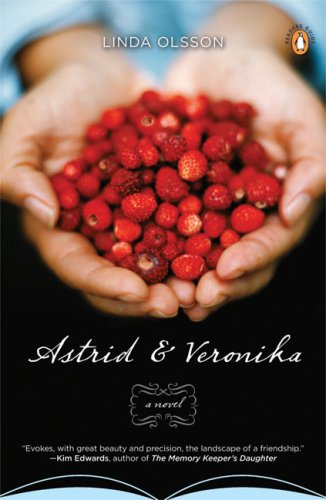
ASTRID AND VERONIKA
With extraordinary emotional power, Linda Olsson’s stunningly well-crafted debut novel recounts the unusual and unexpected friendship that develops between two women. Veronika, a young writer from New Zealand, rents a house in a small Swedish village as she tries to come to terms with a recent tragedy while also finishing a novel. Her arrival is silently observed by Astrid, an older, reclusive neighbor who slowly becomes a presence in Veronika’s life, offering comfort in the form of companionship and lovingly prepared home-cooked meals. Set against a haunting Swedish landscape, Astrid & Veronika is a lyrical and meditative novel of love and loss,
With extraordinary emotional power, Linda Olsson’s stunningly well-crafted debut novel recounts the unusual and unexpected friendship that develops between two women. Veronika, a young writer from New Zealand, rents a house in a small Swedish village as she tries to come to terms with a recent tragedy while also finishing a novel. Her arrival is silently observed by Astrid, an older, reclusive neighbor who slowly becomes a presence in Veronika’s life, offering comfort in the form of companionship and lovingly prepared home-cooked meals. Set against a haunting Swedish landscape, Astrid & Veronika is a lyrical and meditative novel of love and loss, and a story that will remain with readers long after the characters’ secrets are revealed.
- Penguin
- Paperback
- February 2007
- 288 Pages
- 9780143038078
About Linda Olsson
Linda Olsson was born in Stockholm, Sweden. She has lived in Kenya, Singapore, Britain, and Japan. Astrid and Veronika is her first novel.
Praise
“Linda Olsson’s first novel casts the themes of secrecy, passion and loss in the shape of a double helix, intertwining the stories of two women, one young and one nearing the end of life, around the axis of their unlikely friendship.”—New York Times
“Linda Olsson evokes, with great beauty and precision, the landscape of a friendship between two very different women, each caught in a tragic moment from the past. Their connection, initially as tentative and fragile as the first filaments of ice, gradually strengthens, allowing each woman to give voice to her stories, and in doing so to reclaim “a heart for beauty.” Subtle, penetrating, and beautifully written, Astrid and Veronika affirms the power of narrative to transform.”—Kim Edwards, author of The Memory Keeper’s Daughter
“Linda Olsson unravels . . . each woman’s story . . . gradually revealing their grief and loss. . . . This a subtle but powerful novel, tender and poignant.” —The Dominion Post, New Zealand
Not only impossible to put down, but impossible to forget.—Canvas, New Zealand
Discussion Questions
Astrid has been solitary for so long. Why, then, do you think she is drawn to Veronika, essentially a stranger, and then later allows herself to open up to her so freely?
The houses in the novel serve almost as characters. The author describes Astrid’s house as “dark and warm . . . It was an organic part of her and its shapes were ingrained in her body” (p. 9). Discuss how the author uses the houses in the novel. What is the importance of a home in our lives? How does our house/living space define us? What do you think your house/living space says about you?
Astrid’s mother committed suicide when Astrid was six-years-old; Veronika’s mother left when Veronika was a child. Talk about the theme of the “absent mother” and how it influences these characters’ lives.
What did you think of Astrid’s confession regarding the death of her child? Were you able to understand her actions? Did knowing this about her past affect the way you felt about her? What do you think Astrid expected Veronika’s reaction would be to her story? Was Astrid taking a risk in telling her? Why do you think Veronika reacts in the way she does?
Veronika feels very guilty about the death of her fiancé and agonizes over what she could have done differently that day to prevent his death. Why do you think she feels so guilty?
When Astrid tries on the floral swimsuit during Veronika’s birthday “outing,” the women burst out into laughter. (p. 85). Why do the women find this moment so hysterically funny? How does this day, Veronika’s birthday, serve as a turning point in the novel?
After her husband dies, Astrid says to Veronika , “There was nothing more to be afraid of. . . . It was never about him. It was about me” (p.167). What does she mean?
Veronika visits her father after her fiancé’s death, and when she is leaving her father begins to say, “I wish . . .” but doesn’t complete the sentence (p. 200). What do you think he was going to say? How would you describe Veronika’s relationship with him?
Great literary novels skillfully incorporate sometimes elaborate symbolism. In Astrid & Veronika, Ollson makes repeated and significant references to water. Discuss the symbolic function of water in the novel and consider how water may be connected with Olsson’s major themes.
Discuss how the seasons shape the novel. How do the seasons influence the characters? Discuss the ways that the seasons affect you throughout the year? Are your memories connected to the seasons in which they took place?
In her letter to Veronika, Astrid mentions “a great love” (p. 241). Whom do you think she is talking about?
